There are four major pushes in hockey skating (one or two others are not mentioned here). I have named these pushes so that players can easily visualize and remember them. The "stride push" is used for skating straight forward. The "backward C-cut push" is used for skating straight backward. The "X-push" is the second push of forward and backward crossovers. Since a crossover is a two- step maneuver it is also a two-push maneuver. A forward crossover requires both a stride push (first push and an X-push (second push). A backward crossover requires both a backward C-cut push (first push) and an X push (second push). The forward C-cut push is the first push (entry phase) of a pivot or tight turn, and is used for maneuvers that require both agility and stability, such as when warding off an opponent (bulling) or protecting the puck.
Whether skating straight forward, straight backward, crossing over (forward or backward), starting or turning, all skating pushes must adhere to common principles.
There are four elements of every push in hockey skating - the windup, release, follow-through and return. The windup is a coiling action in preparation for pushing; the release and follow through are the actual work done by the pushing leg to generate power and speed; the return is the preparation for the next push.
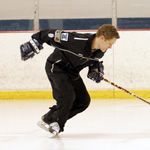
Windup: Edges: Every push is executed against the edges. Some pushes (as in the forward and backward stride) are executed against the inside edge. Others (as in the second push of forward and backward crossovers) are executed against the outside edge. An effective pushing edge is to have the edge of the pushing skate gripping the ice at a 45 degree angle. It is impossible to push against the flat of the blade. Knee Bend: The knee of the pushing leg must be bent strongly during the push. An effective angle of the knee bend during the push is 90 degrees. Popping up, jumping (as too many players do while crossing over), destroys the next push, as well as forward (or backward) motion. STAY LOW at all times! Body Weight and Balance: It is imperative to place all (100%) of the body weight directly above the pushing leg, and to be totally balanced over the pushing edge. Center of Gravity: Every push in skating must be initiated directly under the center of gravity. The center of gravity, which I often refer to as the "battery pack" or "power source" is an imaginary circle, approximately 3 inches in diameter, in the midsection of the body. The reason for this is that when we push, we actually are pushing our body weight; the pushing leg does the work, but we are really pushing ourselves forward or backward. This means that the skates must be close together in order to push effectively - no more than three inches apart.
Release: Every push in skating is executed by driving the pushing leg straight out against the pushing edge. Too many players allow their pushing leg to "slip back" in a walking/running motion. All skating pushes are outward/inward, not backward/forward.
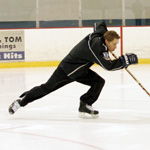
Follow-Through: A push is complete only at the point when the pushing leg is fully extended. Full extension is the point in a push where the entire leg is locked - the hip, the quad, knee, calf, ankle, and toes. The correct finish of the push produces the all important and powerful "toe-flick". Full extension is based upon maintaining a strong (90 degree) knee bend of the glide leg at the point of full extension. A lesser knee bend produces less range of motion and subsequently an inadequate push.
Return: The importance of the return is to prepare for the next push. Remember that the push must be initiated directly beneath the center of gravity. An incomplete return means the skates will be wide apart at the beginning of the next push. If the skates are wide apart the pushing leg will necessarily be outside the center of gravity (battery pack). The subsequent push will be "empty" - in other words, inefficient and ineffective. Players who push from a wide base work hard and accomplish little. They feel as though they're going fast because they move their legs rapidly. Of course they move their legs rapidly - they have a very short range of motion. In actuality they go nowhere fast, and tire very quickly. The goal is efficient speed. To accomplish this, the push must go through the full range of motion.
The One Third Principle: I adhere to a principle which I call the One Third Principle. It is as follows: The first third of a push comes from the back third of the blade, the second third of the push comes from the middle third of the blade, and the final third of the push is comes from the front third of the blade **. Each third of a push is equivalent to one third of the power generated by that push.
What does this really mean? It means that if technique is faulty at any point during the push the player will lose a percentage of the thrusting power (potential speed) of that push. If technique is incorrect at the beginning of the push (windup), the player loses the first third of that push. The second third, or middle of the push (release) is easier than either the beginning or end; most players get this part of the push. Unfortunately, many players ONLY get this one- third of the push. If technique is faulty at the finish of the push (follow-through and toe-flick), the player loses the all important final third of that push.
Loss of even one third of one's potential power results in damaging loss of speed. Loss of two thirds of one's potential power almost guarantees slowness. Fast legged skaters do look fast, but they look fast only because they are churning their legs furiously. Remember - correct, complete and powerful pushes, done rapidly, are the goal.
While walking and running are natural motions of the body, skating motions, and pushes, are not. They must be learned/taught properly and then practiced (correctly and repeatedly) over a period of many years.
** This principle does not apply to "toe starts".
The Benefits of Travel and leisure
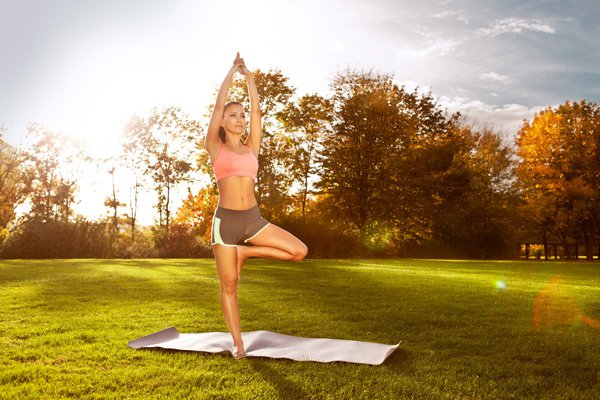
Learn how to jump an extra 4 to 8 inches
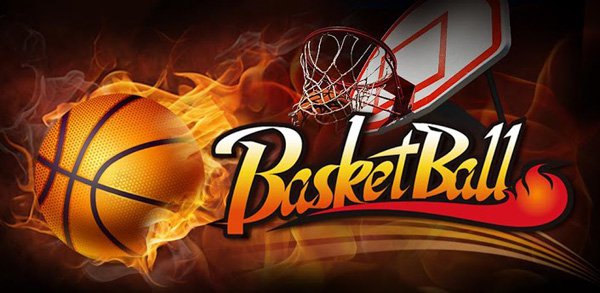
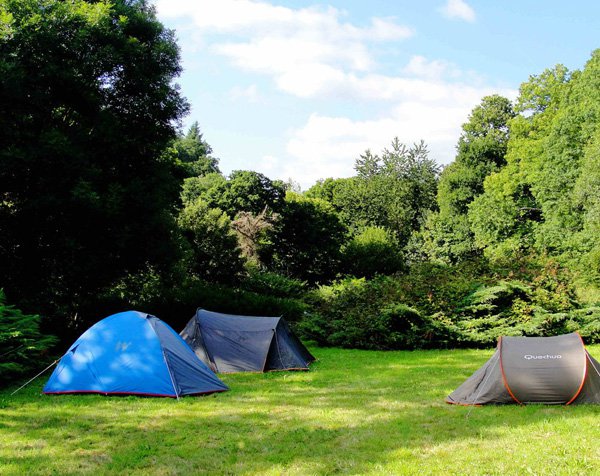
Copyright © www.mycheapnfljerseys.com Outdoor sports All Rights Reserved